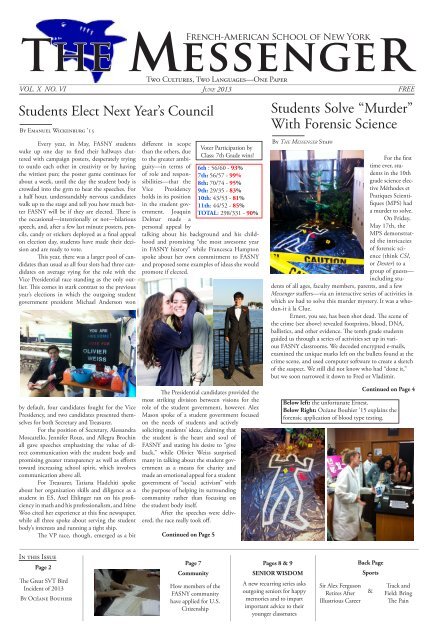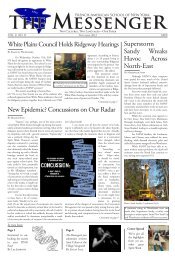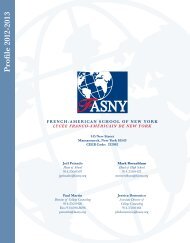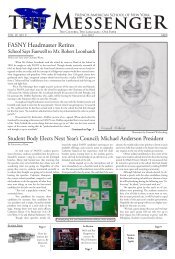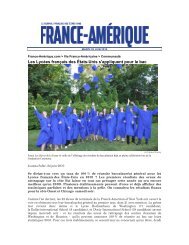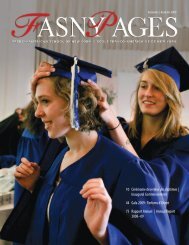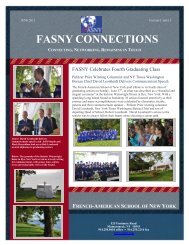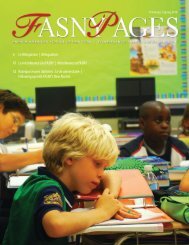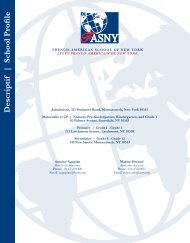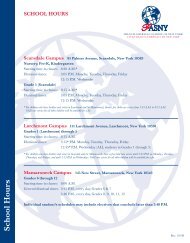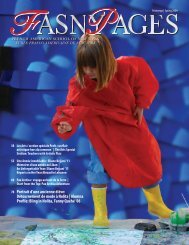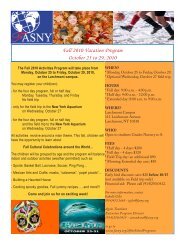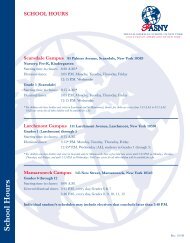Students Solve - Franco-American School of New York
Students Solve - Franco-American School of New York
Students Solve - Franco-American School of New York
- No tags were found...
You also want an ePaper? Increase the reach of your titles
YUMPU automatically turns print PDFs into web optimized ePapers that Google loves.
2Science & TechnologyElon Musk, the next Steve Jobs?By Alex Mason ’14Imagine a car thatmoves stealthily and silentlylike a cat in the night. Imaginea car that can go from 0-60miles per hour in under 4 seconds.Imagine a car that hasno buttons, just a simple 17”touch screen to monitor everything,and finally, imaginea car that possesses all <strong>of</strong> theseattributes, all the while beingsolely powered by electricitywith up to 300-mile range betweencharges.That is a brief description<strong>of</strong> Tesla’s Model S electriccar, which is part <strong>of</strong> CEO ElonMusk’s grand vision for the future.It also happens to be thecar that my dad bought, and henever gets tired <strong>of</strong> it, calling it“one <strong>of</strong> the best decisions <strong>of</strong> myThe Immortal JellyfishBy Léa Jabbour ’14life, right after getting married.”And as he’s fallen inlove with the car, so have I, butadmittedly to a much lesserextent. It is a beautiful, sleek,dark blue, noiseless machinewith a s<strong>of</strong>t beige interior anddoor handles that flitout as you approach.And the best partabout it is that it’s anall-electric car, so notonly is it ridiculouslycost saving (good riddanceto gas stations),not only is it moreconvenient since youjust charge it at homeovernight, but it’s also muchmore efficient, and thus moreenvironmentally sound thangasoline cars are.It’s amazing how Muskhas been able to create such agorgeous, popular car in a downeconomy for car manufacturers,let alone electric car manufacturers,right? It’s incredible thatnot only is the company surviving,it is thriving; it has justproved all <strong>of</strong> its early doubterswrong by making a pr<strong>of</strong>it andturning cash-flow positive, andby having paid <strong>of</strong>f its governmentloan <strong>of</strong> $450 million nineJu n e 2013years early. And yet that’s onlyone aspect <strong>of</strong> his activities tochange the world.In order to create suchmomentous change, Muskneeded to get money; he neededto be an influential, affluentperson. So, in 1995 he droppedout <strong>of</strong> Stanford graduate schoolto start the company Zip2,which he sold four years laterto Compaq for $307 million.He then formed PayPal bymerging his own company,X.com, with another, andsold it eight months later toeBay for $1.5 billion.With those entrepreneurialsuccesses, he hadplenty <strong>of</strong> cash at hand, andwas then able to start to buildtowards his long-term vision.This includes revolutionizingtransportation with Tesla, andintroducing and developing theuse <strong>of</strong> solar panels as a mode <strong>of</strong>clean, efficient, reusable energy.He addressed this throughhis latest company, Solar City,which leases solar panels forless than the electricity utilitybill would otherwise cost.Finally, there’s his mostambitious project: the conquest<strong>of</strong> space. Musk wants tobring back the innovation anddesire to explore that was presentduring the Cold War era,but which disappeared shortlyafter, saying, “I think it’s importantthat humanity becomea multi-planetary species. Ithink most people would agreethat a future where we are aspace-faring civilization is inspiringand exciting comparedwith one where we are foreverconfined to Earth until someeventual extinction event.”To realize this dream,he founded SpaceX, a companythat assembles and launchesrockets into space, and invested$100 million <strong>of</strong> his own moneyto sustain it. He admitted thathe only gave SpaceX a 60%chance <strong>of</strong> succeeding, and itnearly failed. In 2010 he completelyran out <strong>of</strong> cash and hadto borrow money from friends.He would later say that whatkept him invested and believingin his project was its importancefor him: “If something’simportant enough to you, evenif the odds are against you, youshould still do it.”It can only be said thathe has indeeddone it. For example,his latestproject atSpaceX is to reducethe cost <strong>of</strong>rocket launchesby reusing therocket partsthat would usuallybe discardedinto space. Thecompany took a big step towardsthis recently when itmade a 12-story high rocketlift <strong>of</strong>f 820 feet in the air, andland perfectly back in the samelanding spot, which is unprecedented.As a fitting end forthe ambitious Musk’s dreamshe pronounces that he “wouldlike to die on Mars, just noton impact.” Too many peoplehave bet against Musk andlost, so I’ll take his word for it.In 1988, Christian Sommer unwittingly discoveredeternal life, thus debunking the most fundamentallaw <strong>of</strong> the world—the cycle <strong>of</strong> life. ThisGerman marine-biology student was studying hydrozoans—smallinvertebrates that resemble either a jellyfishor a s<strong>of</strong>t coraldepending on theirmaturity—when hemade a remarkablediscovery: one species,the Turritopsisdohrnii, simplyrefused to die. Infact, these jellyfishappeared to progressivelyage in reverse,until they revertedto their earliest stages<strong>of</strong> life, and thenrestarted the cycle.Other scientists joined Sommer in his research andrealized that the species has the ability to transformitself back to a polyp, the earliest stage <strong>of</strong> development,in times <strong>of</strong> crisis. In this way, the organismsachieve immortality.For this reason, the Turritopsis dohrnii isnow commonly referred to as the immortal jellyfishor the Benjamin Button jellyfish. If we could understandhow the species is capable <strong>of</strong> rejuvenating all<strong>of</strong> its cells, we could use the jellyfish’s trick for ourown purposes. Potentially, we could figure out howto slow down aging and cure certain illnesses by revertingaffected or mutated cancer cells back to theiroriginal states. Unfortunately, we still have very limitedinsight on the immortal jellyfish’s rejuvenationmechanism.For now, we just know that in times<strong>of</strong> physical or environmental stress, a sexuallymature 4 to 5 mm long Turritopsisjellyfish undergoes cellular transdifferentiation—aprocess in which one type <strong>of</strong>cell is turned into another (ie. a skin cellturns into a nerve cell)—and essentiallystarts life anew.One reason scientists are not able t<strong>of</strong>ind out more about these jellyfish is thattheir genome, their full set <strong>of</strong> chromosomes,is incredibly difficult to culturein a laboratory. The genome holds all <strong>of</strong>the information on the immortal jellyfish,and analyzing it is really the only way scientists couldpotentially unlock the rejuvenation secrets. Unfortunately,the culture requires an enormous amount <strong>of</strong>close attention, repetitive labor, and specific favorableconditions (that are still mostly unknown) so almostall interested scientists have dropped their research.In fact, only one scientist, Shin Kubota, consistentlycultures Turritopsis polyps in the hopes <strong>of</strong> making aremarkable discovery. He declared, “Once we determinehow the jellyfish rejuvenates itself, we shouldachieve very great things. My opinion is that we willevolve and become immortal ourselves.”This chilling statement may seem surprisingbecause jellyfish and humans are quite different.Surprisingly enough, there is actually a significantamount <strong>of</strong> genetic overlap between the two species.For this reason, unlocking the secrets <strong>of</strong> theTurritopsis’s rejuvenation mechanism could havesignificant implications on human beings and ourmedicine. Who knows, maybe a thousand years fromtoday human immortality will really be a reality.
4CommunityPar Josephine Kehm ’15Ju n e 2013Élèves de secondes programment “The Athlete Quiz” pour iPhoneIl y a quelque mois, deux élèves de seconde ElliottBolzan et Clément Estampes ont développé uneapplication. Aujourd’hui, elle est vendue au App Storeque nous connaissons tous. Voici une interview des cocréateursde «The Athlete Quiz».The Messenger : Expliquez-nous en brefl’application.Clément Estampes : L'application s'appelle "Theathlete quiz". Elle consiste à trouver les athlètes lesplus connus dans les sports suivants: basketball,baseball, tennis, et soccer. Il y a six niveaux par sportet 24 athlètes par niveau. L'application coûte 0.99$ et il existe une version gratuite avec seulement 1niveau par sport.M : Comment avez-vous trouvé le concept derrièrel’application ?C.E : C'est moi qui ai trouvé l'idée. Le concept m'estparvenu lorsque je jouais au Logo Quiz. J'ai alors eul'idée de faire le même type de jeu mais de remplacerles logos par des athlètesM : Pensiez-vous que l’idée rencontrerait du succès ?C.E : J'ai pensé que l'application pouvait avoirun grand succès parce que les applications de quizen connaissaient beaucoup. Malheureusementl'application n'a pas eu autant de succès qu'on pensaitqu'elle aurait eu.Par Océane Bouhier ’15Apparemment, les oiseaux aussi s’intéressent àla science !Si vous ne faites pas partie de ceux qui ontdû passer des heures de souffrances intenables dûes àl'odeur causée par la putréfaction d'un oiseau coincédans les bouches d'aération, considérez-vous chanceux.En effet, cette rumeur qui fit le tour de la FAS-NY fut causée par la classe des sciences et laboratoiredes secondes qui, à la suite d'une expérience sur lesinsectes, entraîna l'arrivée de notre très cher volatile.Cette expérience consistait à observer le cyclede vie des mouches, elle devait durer une dizaine dejours, malheureusement dès le premier week-end, lesuspect s'introduisit dans l'école, ingurgita les larveset se laissa gentiment mourir dans l'un des conduitsd'aération ouvert au plafond. L’agence de maintenanceeut le plaisir de découvrir le lundi matin, nonseulement l'odeur nauséabonde du volatile mais aussisa digestion.Pour couronner le tout, après un nettoyagerapide et efficace, la position géographique de l’animalempêcha sa capture. Cependant la vie devait reprendreson cours, c’est pour cela que l’équipe de maintenanceeut la merveilleuse idée de scotcher délicatement leplafond.Bien évidemment, un plafond scotché nemasque pas l'odeur de l'oiseau en putréfaction. Il fallutdonc une bonne semaine pour dissiper l'odeur d'oeufspourris qui s'en dégageait.L'histoire ainsi dite, l'équipe de l'expériencedont moi, tenons à nous excuser pour les désagrémentset espérons plus aucune “ attaque” de ce genre!M : Combien d’applications avez-vous vendues pourl’instant ?Elliott Bolzan: On a vendu environ 500 applications,un taux plutôt bas. À vrai dire, l'applicationn'a pas bien réussi: le marché des jeux est très compétitif!M : Comment avez-vous choisi les sports et athlètes ?C.E : C'est moi qui ai choisi les athlètes. Je les aijuste choisis avec mes propres connaissances saufpour le baseball où j'ai dû faire un peu de rechercheparce que je ne connaissais pas assez de joueurs.M : Pourquoi Clément as-tu choisi Elliott commeco-créateur ?C.E : J'ai choisi Elliott pour m'aider parce que c'estun de mes meilleurs amis et je savais qu'il avait déjàfait plusieurs applications dans le passé.M : Combien de temps avez-vous mis pour le développementde l’aspect technologique de l’application ?E.B : J'ai dû mettre environ 50 heures pour le développementde l'application. Beaucoup de ces heuresont été passées avec Clément pour réfléchir au designdu jeu.M : Une fois avoir finalisé l’application, qu’elles sontles étapes nécessaires pour ensuite la vendre ?E.B : Pour vendre une application, il faut faire partiede « l'IOS Developer Program », ce qui coûte $100.Ensuite, il est nécessaire de soumettre l'applicationà Apple, qui vérifiera qu'elle est apte. Enfin, elle serapubliée.M : Combien de temps avez-vous mis pour finircomplètement l’application ?E.B : On a été plutôt efficace, en 1 mois, on a complètementfini l'application !M : Combien pensez-vous pouvoir toucher en uneannée ?E.B : En une année, avec les applications à butludique, les pr<strong>of</strong>its sont très variables. Tu peux gagnerdes dizaines de milliers de dollars, ou très peu,en fonction de la popularité. Visiblement, la nôtrefait partie des moins populaires ! Ceci dit, des pr<strong>of</strong>itsaux alentours de $1000 par an sont complètementenvisageables avec notre application.M : Qu’elle est le pr<strong>of</strong>it que fait Apple ?E.B : Apple garde 30% des recettes (cette portioninclut les taxes).M : Diriez-vous que l’application a connu un succès ?E.B : Notre application n'a pas connu un succès. Ilest en revanche important de l'admettre, pour ensuitealler de l'avant. C'est en échouant que l'on apprend!Un Très “Angry Bird” ! Tenth Grade MPS Elective Leads “CSI”-Style LabsContinued from the Front PageThe class, led by Mme. Gilet and Mme. Lopez, showedenthusiasm as it guided us through the tutorials. Indeed,according to Mme. Lopez, the students had greatly enjoyedthis sequence <strong>of</strong> the class, and had put in a significantamount <strong>of</strong> time creating the story, running the necessaryexperiments to fulfill the scenario, and then preparing thelesson plans and presentations to the guests. The teachersgave all the credit for this exciting evening to the students,who worked very hard.By the end <strong>of</strong> the evening, Mr. Faure was adamantVanessa had commited this crime, because she seemed tohave a sinister personality. However, most everyone elseagreed the science pointed to Vladimir. The SVT class confirmedit was indeed Vladimir who had murdered Ernest,after a fit <strong>of</strong> pr<strong>of</strong>essional jealousy involving his coworker’ssuccessful research <strong>of</strong> a cure for cancer.Of course, it was with sadness that we realized thatthough no humans had suffered in the realization <strong>of</strong> thisproject, one animal did encounter a tragic end (see accompanyingarticle, left). That unfortunate event aside, it madefor an exciting and educational evening after months <strong>of</strong>hard work. We look forward to seeing next year’s project!Above: students examine the traces lefton bullets found at the crime scene.Below Left: <strong>Students</strong> present the crimescenario to the numerous guests.Below: Megan Fillion ’15 displays themolding made <strong>of</strong> the suspect’s shoeprint.
Community 5Ju n e 2013<strong>Students</strong> Join Forces in Workshop,Talk <strong>of</strong> Forming a Congress <strong>of</strong> ClubsBy Olivier Weiss ’14As FASNY has developed and evolved, so too have its clubs. They typically consist <strong>of</strong>faculty advisors and have a similar hierarchical, utilitarian student chain <strong>of</strong> command, butthe selection <strong>of</strong> clubs has grown in breadth and depth in tandem with the school’s growth.What has not changed, however, is the independent manner in which each club conductedits business.At least not until recently.In an unprecedented effort to produce greater cohesion and organization for theseclubs, on May 17th, the heads <strong>of</strong> almost every club that the school has to <strong>of</strong>fer, StudentGovernment included, met from 4:00 to 6:00 PM after school in the library to attend whatwas <strong>of</strong>ficially dubbed the FASNY Student Leadership Workshop spearheaded by MireilleBejjani (‘14). The objective <strong>of</strong> the meeting was, according to an email to parents sent byFASNY on May 24th, “to improve student activities at FASNY by showing the studentsbasic skills needed to be leaders,”honing an efficient and structuredagenda for clubs by establishingspecific concrete goals, writingbrief mission statements for eachclub, and brainstorming what goeswrong and what goes right foreach club in terms <strong>of</strong> marketingand execution.The idea <strong>of</strong> simply havingthis get-together to begin withgerminated in Mireille’s mindafter she began The Earth Club,originally known as the RootsThe U.S. Congress in session. FASNY extra-curricularscould benefit from forming a similar alliance.and Shoots Club, last spring, andslowly saw that, in her words, they“weren’t really getting anywhere.”She described the process <strong>of</strong> creatingher club as “frustrating” because <strong>of</strong> a lack <strong>of</strong> clarity as to how to proceed with growingher club.“I didn’t know how to get a new club going and build support and accomplish ourgoals. I realized that I probably wasn’t the only one having some problems. So I thought,‘Why not have a workshop to help all student leaders with any issues they may have?’”The rest came to getting the right people on board. The administration quicklythought it was a great idea once Mireille had presented it, and so they had many follow-upmeetings to bang out the details. Once that was done, she “went looking for facilitators,” orparent presenters “who were both good speakers and had business experience.”She asked FASNY Board <strong>of</strong> Trustees member Mark Kramer, a private equity manager,and former investment advisor Joelle Weiss, both active members <strong>of</strong> the FASNY community,to fill those roles, to which they agreed immediately. After a couple <strong>of</strong> meetings, some deliberation,and some organization and messaging, the date was set for May 17th.The result was what most deemed a success.The room was constantly engaged and actively participated with each activity, whetherwriting out goals, drafting mission statements, talking about negative and positive aspects<strong>of</strong> one’s club, or listening to what Ms. Weiss and Mr. Kramer had to say in relating their businessexperience to FASNY student clubs. Throughout the process, the club leaders seemed tounderstand that every other group had very similar problems such as communication, organization,and accountability, and that they could band together to tackle these issues through acollective endeavor to provide solutions.However, it remains to be seen if the workshop produces any measurable increases inproductivity or efficiency, which will be the true indicator <strong>of</strong> how consequential the meetingwill turn out to have been.Out <strong>of</strong> both a desire to assure the success <strong>of</strong> the workshop as well as to provide for amore unified club environment, representatives at the meeting reached a consensus that thereshould be regular meetings once a trimester in what could be named a Congress <strong>of</strong> Clubs inwhich the Student Government may play an important role as overseer.Sources “close” to the Student Government <strong>of</strong>ficers indicate that there have been briefdiscussions about the matter, but that the substance <strong>of</strong> the proceedings will be discussed duringthe summer.Ninety Percent <strong>of</strong><strong>School</strong> Votes in ElectionContinued from Front PagePosters containing either jokes, witticisms, orcatchy slogans were plastered across the walls as thecandidates schmoozed the electorate. On the eve <strong>of</strong>Election Day, Olivier Weiss and Joaquin Delmar bothreleased YouTube videos in which they made final appealsin different styles. While Olivier gave a heartfeltand serious speech that swayed many who were onthe fence, Joaquin made a compilation <strong>of</strong> studentssaying “Vote for Wawa” with dramatic theme music.On the day <strong>of</strong>, the Presidential and Vice Presidentialcandidates gave out candy in the morning asthe students sleepily piled into school while Alex Masonset up a projector with a photoshopped picture<strong>of</strong> his face cut onto several performers dancing to theNutcracker, and Olivier Weiss put on a sports jacketand some khakis.The next day at recess, the results were in, andthe winners were announced:-Tatiana Hadchiti for Treasurer-Jennifer Roux for Secretary-Joaquin Delmar for Vice President, and-Olivier Weiss for President.The Middle <strong>School</strong> race for president alsocontained much excitement. Jean-Michael Maugüéwon the uncontested Middle <strong>School</strong> Vice Presidentposition and Paul Hadchiti beat out Alexa Jakob andTimothée Clochard for Middle <strong>School</strong> President.The school gave both the winners and the defeateda round <strong>of</strong> applause for their courage to puttheir names on a ballot and get the short end <strong>of</strong> theoutcome.The incoming student council faces many uphillbattles if it intends to implement its charitablegoals as planned and give away 20% <strong>of</strong> its revenuefrom events to charity as well as maintain a cohesivebudget. Another main project that the incomingPresident says is one <strong>of</strong> his top priorities is drafting aStudent Government Constitution, a trial that raisesenough questions about its nature and its process tomake anyone stop and wonder.The <strong>of</strong>ficers, however, maintain that they areconfident that they can accomplish it.A total <strong>of</strong> 298 students voted this year, or 90percent <strong>of</strong> eligible voters who were not absent fromschool that day. Twelth grade students do not votesince they will not be at FASNY the following year.The 7th grade showed the most participation,while the 10th grade turned out the smallest percentage<strong>of</strong> voters. Notably, the middle school grades allturned out in the 90+ percentiles, while high schoolgrades all turned out in the 80 to 90 percent range.Regardless, the voter turnout was extremely high, bytypical standards. The student body appears to havebeen invested in the outcome.And who knows? With this crew, we stillhave hope that next year might just become, ascandidates promised, “the most awesome year inFASNY history.”
CommunityJu n e 20137FASNY Welcomes <strong>New</strong> United States CitizensBy Th e Messenger StaffFor FASNY studentsthe only thing comparablein excitement might begraduating from high school.But for three members <strong>of</strong>the FASNY communitythe thrilling triumph wasbecoming a U.S. citizen.That achievement hasbeen accomplished recentlyby three staff members atFASNY. Here is the list,beginning with the newest<strong>American</strong> citizen: Ms. VrindaTewari, English teacher,upper school; Mr. GilbertEkotto, Dean <strong>of</strong> <strong>Students</strong>,middle school and Ms.Christelle Bidwell, Supervisor.It was “a dream-cometruemoment,” said Mr. Ekotto.“I felt as though I was beingreborn, as the journey thatstarted in Africa, continued toEurope and ended in NorthAmerica unfolded and bledthrough the depth <strong>of</strong> my soul.”Ms. Tewari noted thesame sense <strong>of</strong> a long journey:“After 18 years here, some <strong>of</strong>which I spent in Alabama,Washington D.C. Ithaca,NY, Seattle and <strong>New</strong> <strong>York</strong>City, I felt ready to applyfor citizenship.”She continued: “Theprocess <strong>of</strong> Democracy and theConstitution are inspiring.”She is already thinking aboutfulfilling a right and duty <strong>of</strong>citizenship: “I look forwardto voting for <strong>New</strong> <strong>York</strong> City’sMayor in November, 2013,as I live in Astoria (Queens).”For Ms. Bidwell, itwas an important momentthat was celebrated with hertwo sons. The oldest one,Thibault, a fourth graderat FASNY, was the familyphotographer for the day.These new citizensall speak English and FrenchPhoto by Thibault BidwellChristelle Bidwell signs the documents completing theprocess <strong>of</strong> becoming an <strong>American</strong> citizen.and maintain their sense <strong>of</strong>connection to French culture.But since they live in the UnitedStates, they wanted to becomefully involved in life here.They each said theceremonies and the “moment”were moving and exciting. Mr.Ekotto said he was so “revvedup” at the ceremony that some<strong>of</strong> the inspiring words spokenat the White Plains FederalCourt escaped him. But all thenew citizens shared a sense <strong>of</strong>excitement as little <strong>American</strong>flags were passed out to themand their thrilled families.Ms. Tewari notedthe symbolism <strong>of</strong> America’smulticultural history: “Theswearing-in ceremony wasconducted in Brooklyn courtby an African-<strong>American</strong> judge,who walked into the roomwith his prosecutors: one <strong>of</strong>Chinese origin, one <strong>of</strong> Englishand the other <strong>of</strong> Polish.”These citizenshipevents at FASNY areoccurring even as a nationaldebate about immigration isunderway in the United States.By Alexa Jakob ‘18Photos by Anne CulhaneLook familar? Room 101 was transformed into a Bureau deVote on June 8, 2013 for the French legislative elections. Onthe ballot, FASNY French teacher, Annie Michel. Math teacherJean René Guyot helped with the voting in his classroom.Baby Boom Continues at FASNYThe amount <strong>of</strong> faculty babies at FASNY is as largeas ever!This year, three members <strong>of</strong> the Mamaroneck facultyhave welcomed their sons into the world. Inès Thième,Upper <strong>School</strong> Spanish teacher has enlarged her familywith Tasso Wolf Thieme Wildeman, born January5, 2013, M. Vincent Acezat, 6th and 8th grade mathteacher, and Coralie Michaud, 4th grade French teacher,with Joan Acezat, born March 28, 2013 and JuliaWunderlich, Upper <strong>School</strong> English teacher and studentsupervisor, with Lucas Joseph Wunderlich, born February26, 2013. Welcome to the FASNY community!Naturalization: A First Person AccountBy Karim Tounkara ‘19On Wednesday, March7th 2013, my father,Djibril Tounkara, a bankerat BNP Paribas, was naturalizedin the United States.Naturalization is a legal processin which a person becomes acitizen <strong>of</strong> a country. Naturalizedcitizens in the U.S. are entitledto the same rights and privilegesas natural-born citizens.The day I spent in court withmy father for his naturalization,there were around130 other people – mostlyimmigrants from Mexico.Since this process was set upin alphabetical order, we wereamong the last to go. Then,there was still a two hour longprocess to go through in whichmy dad signed a document thatindicated he was to be a citizen.I wanted to know my father’smotivation so I later asked mydad why he wanted to becomean <strong>American</strong>. His answer wasimmediate: “I became an <strong>American</strong>because I love what thiscountry stands for: The idea <strong>of</strong>liberty, justice for all and pursuit<strong>of</strong> happiness speaks volumes tome. Here, anyone who workshard and respects the law canachieve the <strong>American</strong> dream<strong>of</strong> owning a house and providingfor his family. Democracy,freedom <strong>of</strong> speech and the possibilityto vote for who is goingto represent me in Congressare also reasons why I choseto become <strong>American</strong>. I find itwonderful that <strong>American</strong>s areso proud <strong>of</strong> their country andpledge allegiance to the flag.For all these reasons, I alwayswanted to be an <strong>American</strong>.”And just like that, I understoodwhy naturalization isimportant to so many immigrants:for them, becoming apart <strong>of</strong> the country they havelived in for such a long timerepresents a dream come true.Lucas Joseph Wunderlich Tasso Wolf Thième Wilderman Joan Acezat
8Senior WisdomJu n e 2013Field Trips and Extra-Curriculars Among Seniors’ Fondest MemoriesBy Th e Messenger StaffThey’ve seen, they’ve conquered, and now they’re moving on. We at The Messenger thought the Class <strong>of</strong> 2013 might havesome good advice and some fond memories to share with those students—and maybe some parents or staff—they areleaving behind. We asked them for 1) their fondest memory <strong>of</strong> their time in our school, 2) the most important thing theylearned at FASNY, and 3) their secrets to surviving school. They wrote back—briefly—on Facebook.Robin Deroche1) Fondest memory: The rugby team;2) Most important thing learned: No idea;3) My secret: Be tight with teachers/admin staff.Yannik Buchi1) Fondest memory: skiing in Utah with FAS-NY;2) Most important thing learned: I don’t know;3) My secret: Don't have too many after-schoolactivities or, if you do, don't choose S.Lena Duchene1) Fondest memory: The Williamsburg trip;2) Most important thing learned: Everyone'sweird. Those who aren't, just pretend not to be;3) My secret: An awesome class <strong>of</strong> 2013!Will Bone1) Fondest memory: Thursday Jazz at Lunch;2) Most important thing learned: It’s “Finalement”and not “Au final” (And if you think otherwiseyou're a Bougre d'Âne);3) My secret : Prioritize for homework. There's noway you can always do everything (especially in S).Lola Legrand1) Fondest memory: Senior prank;2) Most important thing learned: You can't possibly finish absolutely everythingeverytime;3) My secret: At least in S, if you want to have a successful academic year:sleep, extracurriculars, and social life --> you can only choose two.Michael Anderson1) Fondest memory: Being part <strong>of</strong> the basketball team;2) Most important thing learned: Keeping perspective and sanity throughoutthe doldrums <strong>of</strong> the school year by reminding myself that the minutiadoesn't mean much in the grand scheme <strong>of</strong> things;3) My secret: Don’t limit yourself socially or from extra curriculars because<strong>of</strong> “too much work.” Its always more manageable than you initially makeit out to be, and having a balanced life is so much more important thanoverworking yourself for no particular reason.Sosena Daniel1) Fondest memory: Senior prank;2) Most important thing learned: ...3) My secret: Finish everything related to SATs (regular test as well as subecttests) in your junior year, don't let it drag on when you’re a senior, it's notfun, coupled with college applications (oh, and also Bac Blancs every week)it will make your first few months <strong>of</strong> your senior year a living hell.Em Kehm1) Fondest memory: Being able to expand my creativity in the Art Department,(Art show, Musicals...);2) Most important thing learned: If you work your hardest, everything willwork out in the end;3) My secret: Get to know the people. It's a small enough community, sotry to take part in as much <strong>of</strong> the FASNY events as you can; they creategood memories...Jacques Guyot1) Fondest memory: Senior prank;2) Most important thing learned: Everyone fallsflat on their face at least once, so don't take onebad grade as a reflection on you as a person; it'sa snapshot in time that becomes meaningless inthe grand scheme <strong>of</strong> things;3) My secret: Try to balance work, extracurriculars,social life, sleep. I tended to always eliminateone (usually social life, <strong>of</strong>ten sleep, thoughin these past two weeks it's been work) --> nota recipe to keep you happy and performing atyour potential. So key word = BALANCE.Penda Sarr1) Fondest memory: UTAH 2013;2) Most important thing learned: I learnedabout optimism and hard work;3) My secret: Always be open to new things; tryto balance out sleep/work/social life.Alexis Sarfati1) Fondest memory: The trip to Bolivia;2) Most important thing learned: The <strong>American</strong>experience;3) My secret: Organization is key to balancingsleep, social life, and work. I don’t think you shouldsacrifice any; I didn’t, and it turned out well.Carla Bennahmias1) Fondest memory: The finale in <strong>School</strong> Musicals2) Most important thing learned: It's actually possible to do well on testswhen you've only slept a couple hours. Thank God for short term memory.So never give up. Study. Even when you think you're screwed, it might saveyour life;3) My secret: Be like Jack Sparrow: make it up as you go along and hopeeverything falls into place at some point because it just might.Julian Salz1) Fondest memory: The first time I heard Mr. Rosenblum speak;2) Most important thing learned: I don't like working;3) My secret: I'm very sneaky.Camille Nakashima1) Fondest memory: The 10th grade Art Show;2) Most important thing learned: To be comfortable in my own skin andhow I dress, to take chances, try new things, express myself and most importantlythere will always be someone who doesn't think you're weird (orthat they are just as weird ^^);3) My secret: Manage your time, balance things out, work hard, don't giveup, and have a good support group whether it be friends or family; it’s hardto get by alone.Marie-Kenza Yousri1) Fondest memory: All the bus rides. I just love bus rides;2) Most important thing learned: Stressing out too much is only going tomake it worse. Don’t panic, and you’ll get through anything, eventually;3) My secret: No matter how packed you think your schedule is already, itcan and will get worse. Deal with it.
Senior Prank 9Ju n e 2013Seniors Advise:StudyingSaves LivesRomane Thomas1) Fondest memory: Opening night for theMusical;2. Most important thing learned; Know yourlimits but keep pushing them. Set one goal andwork towards that;3.My secret: When you don't want to workand you keep procrastinating, lock all electronics(computer and phone and iPod) in the garageand get a pen and paper out: don't thinkabout the work, just do it.Oriana Durand1) Fondest memory: every minute I spent playingon the court or on the field;2) Most important thing learned: 1. Do nottake Option Running in Gym Class. You willdread every Wednesday <strong>of</strong> the trimester; 2. Senioritistends to kick in very hard come Collegeacceptance time; 3. In the Fall, one tendsto underestimate their college results;3) My secret: Be happy. If that means takingtime for yourself, letting go <strong>of</strong> the past or findingthe friends that will support you. Beinghappy will make the stress <strong>of</strong> senior year goby a lot smoother and will ultimately be yourmotivating force to do well.Sarah Amarnath1) Fondest memory: The day we all got intoSciences Po;2) Most important thing learned: Hard workpays <strong>of</strong>f;3) My secret: Remember your roots and staygrounded. Yoga and other stress relieving activitiesshould also help smooth your ride atFASNYVictoria Cassar1) Fondest memory: Lazer Tag with CoachHurley;2) Most important thing learned: “Il faut se rejouirdu bonheur des autres” -Mme. Michel;3) Multiple choices may seem like a joke buttake the SATs very seriously and take TWOsubject tests.Controversial Senior PrankTradition Continues With ’13Though it drew some grumbles from a few detractors, the“Senior Prank” went <strong>of</strong>f without major incident once again this year,with Seniors playing live music, filling the <strong>of</strong>fice with blinking holidaylights, and even introducing live chickens (contained in a pen, as wellas cared for by appropriate personnel) to the mix. A nice touch, thestudents left their teachers a Zen-style rock and sand garden in thefaculty room, complete with meditative rake and Happy Birthday messageto Mrs. Weisholz.Though opinions among students may sometimes vary, views<strong>of</strong> the teachers differ more than one might think. Apologies for thegeneralization, but according to data collected by The Messenger, itseems that for the most part <strong>American</strong> teachers appreciate the SeniorPrank while their French colleagues do not.Asked for comment on a tradition that brings a mix <strong>of</strong> joy andmessiness to FASNY’s end <strong>of</strong> year proceedings, Head <strong>of</strong> High <strong>School</strong>Mr. Rosenblum said, “What the faculty and administation seemed toappreciate about this year’s prank: the positive energy and appreciative,warm and respectful spirit with which it was pulled <strong>of</strong>f. The zenbuddha rock garden installed in the faculty room will be rememberedwarmly together with the c<strong>of</strong>fee, bagels and muffins that the seniorsleft as a showing <strong>of</strong> gratitude for our patience with the disruption.”He added: “We also are grateful that seniors left behind this yeara clear legacy that setting up prank also means taking on the responsibility<strong>of</strong> cleaning it up. What we didn’t like so much was the disruptionto teaching and learning, and the fact that many, many seniors were tootired to attend class afterwards or felt entitled to take the rest <strong>of</strong> the day<strong>of</strong>f. Teaching and learning time is anything but banal and the Bac isaround the corner--for many the stakes are still quite high. Teaching andlearning at FASNY, and the work that teachers do on behalf <strong>of</strong> students,should never be taken for granted or disrupted unnecessarily.”Right: Though theconventional wisdomis that the Seniorsclean up theirmess after the Prank,Carmen Arminioand other members<strong>of</strong> staff usually bearsome <strong>of</strong> the burden.Left: Seniors usedboxes, (live) chickens,a (stuffed) bear,and Christmas decorationsto alter themood around school.The French-<strong>American</strong> <strong>School</strong> Of <strong>New</strong> <strong>York</strong>MessengerEditors-in-Chief: Emanuelle Rizk & Olivier WeissManaging Editor: Emma GuyotSenior Editors: Armand Latreille & Julian SalzAssistant Editor: Emanuel Wickenburg Sports Editor: Paul Castaybert Design Editors: Clemence Wassen & Irène WooIn Review Editor: Irène Woo Copy Editor: David Guyot Drawings by Louis Le JamtelReporting Staff: Nour Aljowaily, Matthieu Anconetti, Michael Anderson, Tatiana Brochin, Thomas de Villemejane, Joaquin Delmar,Jurnivah Desir, Elsa Dupuy d’Angeac, Oriana Durand, Chloe Durland, Anatole Grablevsky, Zoé Guyot, Léa Jabbour,Alexa Jakob, Emilie Kehm, Josephine Kehm, Maddie King, Zoé LaPomme, Alex Mason, Maxim Mounier, Hai Nguyen, Eliwa Onanga,Mathieu Rizk, Jean-Baptiste Robert, Margaux Salz, Mathieu Salz, Jacqueline Sarro, Alex Sherman, Sabrina Sherman, Iona Sobral,Karim Tounkara, Lorenzo Vitale, Declan Wicks, Camille WilliamsVOL. X NO. VILycee <strong>Franco</strong>-Américain de <strong>New</strong> <strong>York</strong>French-<strong>American</strong> <strong>School</strong> <strong>of</strong> <strong>New</strong> <strong>York</strong>Faculty Advisors: Mrs. Anne K. Culhane, Mr. Tom FaureSpecial thanks to Julia Wunderlich145 <strong>New</strong> Street, Mamaroneck, NY 10543(914) 250-0000 www.fasny.org
10In reviewJu n e 2013The Best Medicine: 50/50,A Comedy About CancerBy Irène Woo ’15Laughter, they say, makes the best medicine.Sure, when one has to describe the movie 50/50, one will tell youthat it is “about cancer, but still funny.”This may not immediately make any sense, simply because cancerand comedy seem to have nothing in common. Yet, they do, and as intriguingas it sounds, 50/50 (2011) displays this feeling very well while stayingclose to the reality <strong>of</strong> one having cancer.It wouldn’t be the first time a serious subject was treated lightly. Justask Kurt Vonnegut, who was a master <strong>of</strong> gallows humor.When the movie opens, the audience meets Adam (played by JosephGordon-Levitt), a shy twenty-seven-year-old who still cannot drive and liveswith a girl who, intuitively, may cheat on him. He works at a local radio stationwith his friend Alan (Seth Rogen), with whom he seems to have nothingin common. Alan is crass and immature, constantly on the prowl for aone night stand, while Adam seems like a serious, budding journalist.Adam complainsabout his back, he goesto see a doctor, who willgive him the reason <strong>of</strong>this pain: a spine tumor.This, <strong>of</strong> course, comes asa shock to all <strong>of</strong> Adam’sfriends, even more than tohimself. He reiterates thataside from some back painhe’s feeling great.A masterfully wellplayed movie, 50/50 allowsus to truly immerseourselves into Adam’s dailylife, focusing mostly onwhat is happening in front<strong>of</strong> us and not elsewhere.This is clearly more thanpure and good entertainment,but also a way toenable catharsis to happen.While one might be cynical,it truly is helpful t<strong>of</strong>ind a character dealing with a much more important issue than ours, andstill overcoming it.Honestly and frankly, the ending <strong>of</strong> the movie is not as surprising asone might think, but the journey leading to the climax <strong>of</strong> the movie is trulyworth watching. 50/50 can make you cry as well as it can make you laughabout the stupid questions people might ask about cancer (which you maylaugh for because you just may recognize yourself among those asking suchsilly questions about the pain, the chemotherapy, the side effects). A mixture<strong>of</strong> serious pathos and humorous, even slapstick drug-related incidents,achieve a satisfyingly balanced tone.This movie gives us a simple and honest perception <strong>of</strong> what it trulymeans to get cancer. Every character seems to contradict our prejudices andto escape the Hollywood stereotypes, except maybe the young psychiatrist,nicely played unconvincingly by Anna Kendrick. It’s not that she is just astock character, but her romance with Adam tends to be a little bit exaggerated.Keeping her as a friend might have fit well enough, I guess.50/50 is not a Hollywood blockbuster, compared for example to thenew movie Man <strong>of</strong> Steel, but it is definitively worth watching for anyonewho does not want to focus on a twisted plot, double meanings, or why thismovie was acclaimed, but simply to be well-entertained.John Green’s Teen DramasEnthral, No Vampire RequiredBy Elsa Dupuy d’Angeac ’17"There is a permanence to the present tense. An infinity within thefinite. The present tense is always present. It is always happening now."So says <strong>New</strong> <strong>York</strong> Times best selling author John Green when speaking<strong>of</strong> his recent book The Fault in Our Stars. Although Mr. Green startedout as a Youtube blogger with his brother Hank, he soon became the author<strong>of</strong> four <strong>New</strong> <strong>York</strong> Times best selling books, each published in over adozen languages. Both The Fault in Our Stars and Looking for Alaska tellstories <strong>of</strong> adolescent love and hardships and both conclude with heartwrenchingtwists. Although in the end you will probably cry, the path tothe actual crying will be filled with different tears caused by the hilarity <strong>of</strong>John Green's writing.The Fault in Our Stars tells the moving love story between 16 yearold Hazel Grace and 17 year old Augustus Waters. The book begins whenthe protagonists meet at a cancer support group. At the time, Augustusis recovering from osteosarcoma and Hazel is undergoing treatment for alung tumor. The reader soon discovers that Hazel's cancer is terminal, andlearns that she has resolved to befriend as few people as possible for fear <strong>of</strong>hurting them when she dies. Nevertheless, Hazel can't help but fall for Augustus'scharm characterized by an irresistible combination <strong>of</strong> good looks,humor, and smarts. The two become very close and Augustus decides touse his wish from the Wish Foundation to take Hazel to Amsterdam wherethey plan to meet their favorite author.Looking For Alaska is told from the point <strong>of</strong> view <strong>of</strong> Miles, a 16year old boy. The book opens with Miles leaving his home in search <strong>of</strong> the“Great Perhaps,” which he plans to find at Culver Creek Boarding <strong>School</strong>.There, he meets what will become his best friends Alaska Young, Takumi,and Chip (the Colonel). Together, the four go on extraordinary adventures,which include finding Miles a girlfriend, pulling priceless pranks on theentire school, and <strong>of</strong> course, getting into plenty <strong>of</strong> trouble.Both are enthralling novels that portray the drama-filled lives <strong>of</strong>16- and 17-year-olds. At the beginning <strong>of</strong> both books, the narrators areslightly depressed, although throughout the story their crushes reliably distractthem from their morosity. Although the underlying theme in LookingFor Alaska is not as serious as the one in The Fault in Our Stars, the book isstill captivating.John Green's books are filled with symbolism that tends to be hardto grasp. After a while, though, the reader becomes accustomed to the style,and finds herself dissecting the pages in search <strong>of</strong> signs. However, I recommendreading the Q&A at the end <strong>of</strong> his books in order to fully understandtheir meanings. Another one <strong>of</strong> John Green's trademarks is a surprisingand <strong>of</strong>ten sad twist at the end <strong>of</strong> his books.I really enjoyed both books because <strong>of</strong> their story lines and originalcharacters. Nevertheless, what kept the pages turning wasn't Augustus'scharm or the Colonel's smarts, it was the way John Green writes. His booksare written in detail; they are funny yet at the same time, smart. I recommendthis book to any mature reader who can handle serious topics, humor,and a book they can really get lost in.
Science/Opinion 11Ju n e 2013La dérive des continents selonWegener : pour ou contre ?Un jeu de rôle a été proposé aux élèves de 4e par Mme. Lopez. Ilsdoivent écrire un article de journal en se plaçant à l’époque d’Alfred Wegeneret de la théorie de « la dérive des continents ». Un groupe écrit unarticle en faveur de la théorie et l’autre groupe rédige un article qui doitapporter des arguments contre.Article 1 : La dérive des continents, une nouvelle théorie scientifique.Par Edgar Doyet, Andrea Lafuente, Tessa Lagaüzeire, Mounia Tarib.Mr Alfred Wegener est un scientifique allemand qui essaie dedémontrer que les continents se déplacent. En réfléchissant, il découvrela présence de fossiles (animaux et végétaux) semblables et ayantvécu à la même époque dans deux continents différents : l’Afrique etl’Amérique.Si nous observons la forme des continents il est facile de remarquerleur emboitement. La théorie de Mr Wegener est tout à faitpertinente.Malheureusement, certains scientifiques sont en contradictionavec la théorie de Mr Wegener en s’opposant à la dérive des continents.L’aspect logique des arguments de ces scientifiques peut influencer certainslecteurs. Cependant, étant donné l’emplacement des continents, lathéorie de la dérive des continents est tout à fait possible.Article 2 : Mr Alfred Wegener a-t-il raison ?Par Gaspar Alvarez, Milo Sobral, Grégoire WooUne nouvelle scientifique a été révélée hier. En effet Mr AlfredWegener a présenté au Congrès International des Scientifiques de Viennesa théorie : les continents auraient dérivés ces derniers millionsd’années. Il a nommé ce phénomène la dérive des continents.Nous rencontrons Albert Wreuvoirwoo *, scientifiquerigoureusement opposé à la théorie de Wegener et anti-mobiliste.Voici ses arguments : la principale faiblesse de la théorie de Wegenerest son explication. En effet, Mr Wegener dit que les mouvementsdes continents sont liés aux mouvements de la lune tels que la marée.Cette théorie ne tient pas la route d’un point de vue physique selonMr Wreuvoirwoo.(Note aux lecteurs : A l’époque, les mouvements de convection enpr<strong>of</strong>ondeur étaient ignorés des scientifiques.)* Pour des raisons d’anonymat, le nom de cette personne a été modifié.Did you know?By Mathieu Riz ’17-Banging your head against a wall can burn up to 150 calories an hour.-Sneezing kills brain cells.-<strong>New</strong> England is bigger than England.-In your life, you will have eaten 8 spiders while sleeping.-0.2% <strong>of</strong> people die on their birthdays.-It is slighlty more likely for a penny to fall on tails than on heads.-Uncopyrightable is the longest word in the English language thatdoes not use the same letter twice.-The lowest point in Colorado is higher than the highest point inPennsylvania.-Snails can sleep up to 3 years.-More than 90 people die per year choking on their pens.A Sisyphean Senior YearIntercoursA Column That Strives Not To Include Mature SubjectsBy Michael Anderson ’13 and Armand Latreille ’13This is the end <strong>of</strong> Intercours, the column that strived not to include mature subjects.As this edition was being put into print, we authors were not clear if there ever wouldbe a successor to write and complain about the everyday troubles in our otherwise very dulllife. You may have noticed (we hope so) that Intercours was scandalously not present in thelast issue <strong>of</strong> The Messenger. So for our last column after a long and enjoyable career in thisesteemed newspaper, we chose to go out with a bang. The topic choice for this issue wasalmost a no-brainer. What do Senior year at FASNY, the US Marine Corps boot camp, the<strong>New</strong> <strong>York</strong> City marathon, and a dentist appointment all have in common?All <strong>of</strong> them are long, grueling, butmake one very happy to be finished. This isdue in no small part to the College ApplicationProcess, which is so huge that we neededto capitalize it. On top <strong>of</strong> the insane amount<strong>of</strong> work that is required to validate one’s High<strong>School</strong> career (with the notable exceptions <strong>of</strong>the lucky few who only apply to universitiesthat do not require a kidney donation for admission),the yearlong stress and anticipationhas made us grow grey hairs well before ourtime. For reference, one <strong>of</strong> the authors <strong>of</strong> thiscolumn (hint: the tall one) has been awakesince October and steadily surviving on unhealthyStarbucks Double-Shot c<strong>of</strong>fee drinksfrom Hess Express. Bref, this Intercours isn’tan advice column. It’s a warning. A warningto leave while you still can.If that wall <strong>of</strong> text wasn’t enough,here’s what to expect <strong>of</strong> your Senior Year:1) That one student who has everything planned. College list finalized in May <strong>of</strong> Junioryear, SATs done by June, Essays completed by August, and everything ready way beforethe deadline.2) Common App: O venerable and cruel Goddess. She giveth what she taketh. Considersacrificing goats before getting started on the college apps process for best results, itworked for one <strong>of</strong> the authors but we’re not telling you who.3) Speaking <strong>of</strong> which, when the Common Application site outranks Facebook on yourmost visited sites, you know your life has become college-centric.4) It’s a marathon, not a sprint. And you don’t get to pick where the finish line is.5) The blank page syndrome. You sit down at your computer, put the essay prompt infront <strong>of</strong> view, and take three deep breaths. Hours later, you are still there, and there arenow rods on the blank word page before you. The stupid cursor is blinking, saying “whatnow?” You go cry in the shower.6) Bac Blanc Tuesdays: tears, nausea, and defeat. Bac Blanc Week: cerebral enema. It’sespecially painful when the day is so advanced by the time that a student is finished withtheir four-hour calvary that it is pitch dark outside, and you need to go home and work.7) Senioritis: or lumpiness <strong>of</strong> the collective Senior soul. Trying to find a balance betweentime spent on the Internet and watching TV is key.8) Rejections will be handed out, and they will most likely hurt. At best, it teaches youhumility and makes those acceptances even sweeter. However, rejections also coincidewith a moment when most students realize they aren’t the wonderfully original and brilliantindividuals they thought they were. [Advisor’s note: yes, you are.]9) Utah: double blacks to be avoided with caution. Math revisions to be avoided withmore caution.10) The Senior Lounge is crowded, messy, disgusting, and ultimately a good metaphorfor your Senior year. At recess, half <strong>of</strong> the grade will be sleeping on a couch supposed tohold four individuals.11) Don’t become like Sisyphus. If you don’t get the reference, read Camus’ essay on thematter, it will help you for philo always.12) Speaking <strong>of</strong> which, it’s normal and totally to be expected to underperform in thevery noble subject that is Philosophy. However, it doesn’t mean you shouldn’t enjoy it.Madame Sachinis’ cours is like the Greek god’s nectar: it’s the greatest thing on Earth,but not everyone can appreciate its strength.And last but not least: Murphy’s Law: important sports events will always take place thenight before important tests.
Sh a r kSp o r t sJanuar y 2012Soccer Legend “Fergie” RetiresAfter 26 Great Years at Man Utd.By Joaquin Delmar ’14Sir Alex Ferguson: arguably the best football manager <strong>of</strong> all time. Whatthis man did for the game was unprecedented. He created a worldwide dynastyby winning 13 Premier League titles, 5 FA Cups, 4 League Cups, 2 UEFAChampions Leagues, a FIFA Club World Cup, a UEFA Super Cup, a UEFACup Winner’s Cup, an Intercontinental Cup, and 10 Community Shields. Notonly does his silverware mark a successful pr<strong>of</strong>essional career, but also his way <strong>of</strong>running a pr<strong>of</strong>essionalteam is whatcharacterizes him.He made ManchesterUnited aforce to be reckonedwith since hebecame the club’smanager in 1986.He arrived at aclub at the brink <strong>of</strong>relegation. Withoutresorting to thewinter transfer window,he slowly got“You’ll be sacked in the morning!”—British soccer fans, showingtheir trademark sense <strong>of</strong> humorManchester Unitedout <strong>of</strong> the bottom 4and had them finishin 11th place. ChallengingLiverpool’sdomestic and foreignreign was an enormous challenge he had to face. Recently he just stated that:"My greatest challenge is not what's happening at the moment, my greatestchallenge was knocking Liverpool right <strong>of</strong>f their [explicit] perch.” By slowly improvingManchester United’s athletic situation, he was able to culminate all hisefforts with a couple trophies for the club. The later arrival <strong>of</strong> Eric Cantona, one<strong>of</strong> France’s best strikers <strong>of</strong> all time, allowed Sir Alex Ferguson to propel Unitedinto a glorious period <strong>of</strong> success. Year after year he guided his team to success,destroying Liverpool’s domination in England.Players like Ryan Giggs, Paul Scholes, David Beckham, Cristiano Ronaldo,and Wayne Rooney joined United in their respective time periods. Talentthat had never been seen in Manchester suddenly was knocking at the RedDevil’s doors since the 1990’s. Because <strong>of</strong> Sir Alex Ferguson, Manchester Unitedbecame an attractive team for worldwide super talents. He had a particular eyefor talented players across the globe and gave a chance to young gifted playershe found. This is what he had to say about Ryan Giggs, a man who played hiswhole career at Manchester United : "I remember the first time I saw him. Hewas 13 and just floated over the ground like a cocker spaniel chasing a piece <strong>of</strong>silver paper in the wind."Sir Alex Ferguson became an emblem <strong>of</strong> Manchester United. He symbolizedand enveloped the concept <strong>of</strong> success. No other manager had directed ateam for so long. He was careful to detail, as he never made outrageous, overlyexpensive signings. He adopted a very dynamic style <strong>of</strong> play, attacking anddefending with multiple players. He made all other English clubs envious <strong>of</strong> hissuccess, style <strong>of</strong> play, and loyalty to a fan base.When Sir Alex Ferguson announced in May 2013 that he would retire,the world bowed down to this man. All opposing fans from Chelsea, Liverpool,Manchester City, and many other clubs respected what this man did for thesport. Ferguson stands as a synonym for victory, perseverance, and hunger toachieve. What he leaves us is bigger than what we lose. All managers will striveto be like Sir Alex Ferguson. All small clubs will have the dream <strong>of</strong> emergingvictorious from the shrouds <strong>of</strong> adversity. This manager created a revolution forclub football all across the globe."The decision to retire is one that I have thought a great deal about andone that I have not taken lightly. It is the right time."It is a shame to see such a great man go. He leaves having been the mostnotorious manager in England and surely one <strong>of</strong> the most influential men forfootball in history.Vous aimez les crampes?L’athlétisme est pour vous!Par Emma Guyot ’15 & Iona Sobral ’15Cette année la FASNY a vu naître une nouvelle équipe desport: l’équipe d’athlétisme! En high school, cette équipe (dont nousavons l’honneur d’en faire partie) est malheureusement en effectifsassez réduits: dix élèves seulement s’y sont joints. Les collégiens secomptent plus nombreux.Louise Billault ’17, one <strong>of</strong> the many enthusiasticmembers <strong>of</strong> the new track and field team.Mais nous comptonsparmi nous d’excellents athlètes.Nous avons pu, malgrél’adversité et l’oppression,et grâce à une persévéranceépique, remporter (haut lamain!) toutes les rencontresqui ont eu la malchance decroiser notre route.Nous avons comptésdans nos rangs Jennifer Rouxet Kiara Bernard, les sprinteuses,et nous deux, EmmaGuyot, coureuse de longuesdistance, et Iona Sobral, produ lancer de poids. Du côtédes garçons, Jacques Guyot,coureur d’endurance, AlbanDouady, coureur de demi-fondet lanceur de poids, et ElliottBolzan, Augustin Baugier, etHugo Delavalle sprinteursqui, avec Antoine Volard,coureur de 400 mètres, fontle saut en longueur et letriple saut.Nous recrutons!L’année prochaine, pensez au“track & field.” Vous aimezcourir, sprinter, sauter, passerun bâton, lancer des trucslourds, vous essouffler, ouencore avoir des crampes auxjambes et des points de côté?L’athlétisme est le sport pourvous!Marc-Erwin Djomo ’17 and SéraphinBassas ’18 execute the hand-<strong>of</strong>f <strong>of</strong> thebaton with perfect timing.


